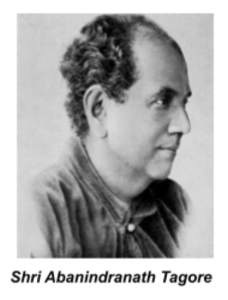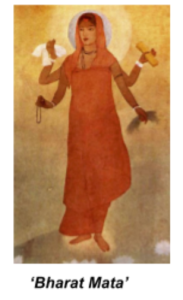By Anaya Goel
The Visual Arts played a significant role in India’s freedom struggle, and vice versa. The freedom movement encouraged several local enterprises and industries, as a result, Indian art prospered and was soon influencing awareness amongst the people.
India’s traditional art is rooted in it’s mythology and religion, it has been influenced by the different eras and periods that it has experienced, such as the Indus Valley civilization (3300-1300 BCE; mature period 2600-1900 BCE) and the Mughals period (1526 CE- mid-eighteenth century) and the British Raj (1858-1947).
Once the Britishers colonised India, a declining trend was noticed in the Mughal and Rajput styles, whereas a course of European inspired art grew. Additionally, the determined dissemination concocted by the British Raj acted as a catalyst in this process. The arrival of the British East India Company all over India resulted in a breakthrough moment where the Nawabs and the Maharajas of India took a fancy to collecting European Artworks.This later gave birth to the art movement, Bengal School of Art, a blend of the Oriental style of painting and the Occidental.

Originated in the Kolkata district in the late 19th century, The Bengal School of Art was an art movement based on a modernist and nationalist approach. It was formed as a result of the Swadeshi Movement, which had influenced the upswing of Indian culture. Up until then, traditional art was suppressed by the British Raj. Significant Artists, Abindranath Tagore and E.B Havell, founders of the Bengal School, promoted the abandonment of European art, moreover, Tagore wrote the journal- Indian society of oriental art to popularise swadeshi values in art. The movement also influenced Japanese nationalists such as Kakuzo Okakura and moulded modern artists Gaganendranath Tagore and Jamini Roy.
Shri Abanindranath Tagore’s paintings serve as a notable example of how Indian art influenced the Freedom struggle.
Tagore, the artist whose brainchild the movement was, had a distinct style of the Rajput and Pahari style with the academic style of European art. His paintings featured sentimental content amongst the Indian Heritage. Notably, a prominent painting of Tagore’s ‘Bharat Mata’ showcases his unique wash technique style. Similarly, his painting ‘Last Days of Shah Jahan’ represents his authentique style. Both these paintings share a common theme of the arrival of a new direction Indian Modern Painting and play a key role in India’s Freedom Struggle. Such paintings propelled nationalist sentiments, prevailing over paintings that were previously dominated by themes of gods and goddesses.


Female artists such as Amrita Sher-Gil portrayed female roles in the freedom struggle, motivating women of India to step up for their freedom.
Her oil-painted works involved a fusion of European, Pahari and Ajanta art, mainly influenced from village women going about their daily tasks, evident from her painting ‘Bride’s Toilet’. “Her themes are predominantly oriented around women and allude to the agency of feminist thought and identity, Her women were not necessarily beautiful ladies from affluent families, but she depicted them with great empathy, not as tragic figures but as individuals in their own right,” says Dinesh Vazirani, co-founder of Saffron Art. She aimed to take Indian Modern Art forward by addressing how essential it was to incorporate international aesthetics within Indian art. Her piece ‘the storyteller’ was auctioned for a groundbreaking INR 61.80 Cr in 2023, hitting yet another milestone in Indian Art. Even in the 21st century, years after her passing, Amrita Sher-Gil continues to be a pioneer for Indian Modern Art.
One can agree that Art played an important role in the Freedom struggle during the early 20th century, furthermore, the rise of Indian Modern art uplifted a new generation of Indian Artists.
“Amrita Sher-Gil – Google Arts and Culture.” Google Arts & Culture,
http://artsandculture.google.com/entity/amrita-sher-gil/m09sphm?hl=en.
Bhandari, Parul. “On Amrita Sher-Gil’s Birth Anniversary, a Closer Look at the Women in Her Paintings.” Scroll.in, 30 Jan. 2021,
scroll.in/article/985478/on-amrita-sher-gils-birth-anniversary-a-closer-look-at-the-women-in-her-paintings.
ForumIAS. “How Freedom Fighter’s Used Art and Literature in India’s Freedom Struggle.” Free UPSC IAS Preparation for Aspirants, 3 May 2021,
forumias.com/blog/answered-discuss-how-art-and-literature-influenced-indias-freedom-struggle/#:~:text=Thus%2C%20art%20and%20literature%20played,unite%20mass%20against%20colonial%20forces.
Gallery, Dhoomimal. “Brief History of Modern Art in India: Pre-Independence – Dhoomimal Gallery.” Dhoomimal Gallery,
www.dhoomimalgallery.com/post.php?id=145.
Journal of the Indian Society of Oriental Art | Ideas of India. – www.ideasofindia.org/project/journal-of-the-indian-society-of-oriental-art.
Mahotsav, Amrit. “The Swadeshi Movement and the Bengal School of Art.” Azadi Ka Amrit Mahotsav, Ministry of Culture, Government of India,
amritmahotsav.nic.in/district-reopsitory-detail.htm?14337#:~:text=During%20the%20Swadeshi%20movement%2C%20the,of%20Indianizing%20education%20in%20art.
Peace, History For. “From Swadeshi to the Constitution: Nandalal Bose and the Nationalist Project-Siva Kumar.” History for Peace, 17 Aug. 2021,
www.historyforpeace.pw/post/from-swadeshi-to-the-constitution-nandalal-bose-and-the-nationalist-project.
“The story behind Amrita Sher-Gil’s record-breaking INR 61.80 Cr painting.” ADLIST, 7 Oct. 2023,
www.architecturaldigest.in/story/amrita-sher-gils-female-muses-the-story-teller-auctionsfor-a-record-breaking-inr-6180-cr.
Accessed 4 Aug. 2024.
Wikipedia contributors. “Abanindranath Tagore.” Wikipedia, 24 July 2024,
en.wikipedia.org/wiki/Abanindranath_Tagore.
B-120, VIVEK VIHAR PHASE-1, SHAHDARA, DELHI-110095, INDIA